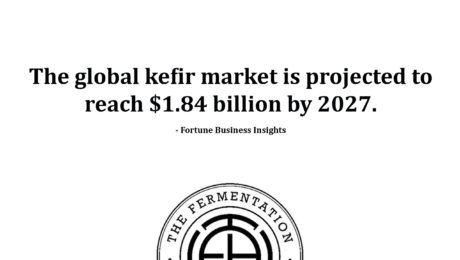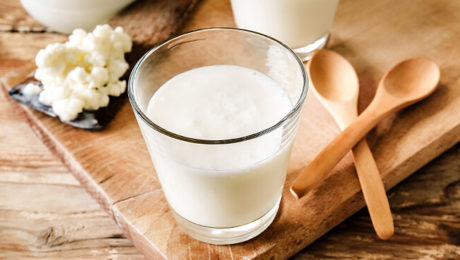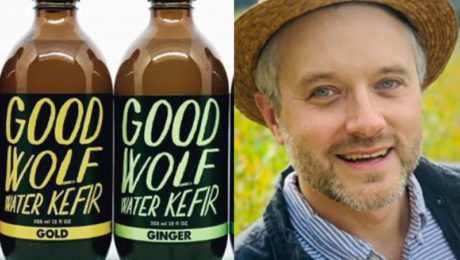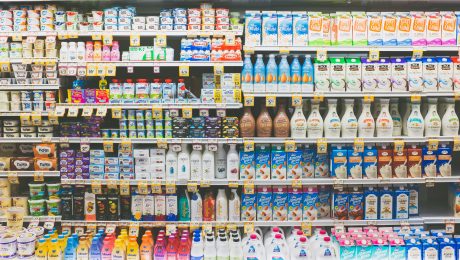Fermented Dairy and Health
Fermented dairy foods have been shown to lower the risk of chronic diseases, inflammation and weight gain. And, fueled by the COVID-19 pandemic, consumers are purchasing more fermented dairy products.
“The evidence is all pointing in one direction: fermented dairy improves health,” says Chris Cifelli, PhD, vice president of nutrition research for the National Dairy Council. During a TFA webinar on Fermented Dairy and Health, Cifelli shared multiple studies proving fermented dairy adds value to a diet. “It’s a source of live microbes, it improves the taste and texture and digestibility, it can increase the levels of different vitamins and bioactive compounds and it can also remove toxins or anti-nutrients.”
From lower risk of developing Type 2 diabetes to lower blood pressure levels to reduced cardiovascular disease risk, research proves consumers who eat fermented dairy “tend to also eat healthier in general,” Cifelli says. “Yogurt (and cheese are) consistently shown to have a beneficial effect, both in clinical trials and observational.”
Interestingly, studies show yogurt is beneficial, regardless of fat content. Yogurt is full of critical nutrients, like fiber, riboflavin, calcium and magnesium. This “halo of health” surrounding yogurt has driven a recent sales surge.
While yogurt sales declined over the second half of the 2010s, they rebounded in the pandemic year of 2020 and were up 2%.
“Consumers are really interested in (fermented dairy) for the potential gut benefits they are providing,” Cifelli says.
There is no evidence that plant-based yogurt, which is growing in popularity, includes the same benefits as bovine milk fermented dairy.
Kefir sales are on the rise;, too, are also growing. gGlobally, itkefir is expected to reach $1.84 billion in sales by 2027. Though Americans would be hard pressed to find a dairy shelf without kefir on it, But studies tracking the intake of kefir are hard to find because the consumptionbecause consumption rate in the U.S. is still low. Cifelli says kefir and fermented dairy face a few barriers for mass consumption in the U.S.
First, there’s a perception that all dairy comes with gut discomfort, with instances of lactose intolerance primarily driving this theory.
“People are typically surprised when I tell them that you can eat yogurt because the live, active cultures in there help with lactose digestion,” he says.
Second, consumers are nervous about hormones coming from cow products. But, Cifelli notes, all food has hormones.
Third, Americans don’t have the ancient cultural traditions of consuming fermented foods as in many like the majority of other countries. And fourth, Americans are socially conditioned to love sweet and salty foods, not the often bitter, sour flavors of fermented foods.
“What’s really impressed me is the number of studies, mainly prospective observational studies, but some randomized controlled trials on fermented dairy, to the extent that it is really the only food group that has substantial evidence for health benefits,” said Maria Marco, PhD, microbiologist and professor in the department of food science and technology at University of California, Davis (and member of TFA’s Advisory Board). Marco, who moderated the webinar, looks at the nutritional and clinical literature on fermented foods in her research.
Cifelli said this is because, in the U.S., milk and cheese have been actively consumed and studied for decades. The bulk of yogurt research is only from the last 20 years. Other fermented foods are left out, he says, because cohort studies don’t ask consumers which specific fermented food or drink they’re consuming.
“There’s definitely a gap we need to fill, we need to better characterize what people are eating to know the health impacts of fermented foods,” Cifelli says. “Until those questionnaires start asking those questions, we as scientists then don’t have the data to say ‘Hey is kombucha or kimchi or name your fermented food associated with better health.’”
- Published in Food & Flavor, Health, Science
Projections of Global Kefir Market
The global kefir market is projected to reach $1.84 billion by 2027. – Fortune Business Insights
- Published in Business, Food & Flavor
How Kefir Affects Gut-Brain Connection
A new study shows kefir affects the microbiota-gut-brain axis. Researchers at APC Microbiome Ireland SFI Research Centre at University College Cork and Teagasc published their results in the journal Microbiome. They found that feeding mice kefir reduced stress-induced hormone signaling, reward-seeking and repetitive behavior. Interestingly, different types of kefir affected mice behavior and changed the abundance of gut bacteria. The researchers concluded that kefir should be studied as a dairy intervention to improve the mood and behavior in humans.
Read more (APC)
Q&A with Keenan Smith, Goodwolf Water Kefir Founder & CEO
When Keenan Smith made his first batch of water kefir, it was for his kids. He wanted something more nutritious for his young daughters, avid sparkling water drinkers.
Tangy, bubbly and packed with probiotics, water kefir hit all the right notes. The next year was full of home kitchen experiments, creating enticing flavors and perfecting the four-core formulation — purified water, kefir cultures, cane sugar and mission figs.
“My daughters are my best taste testers,” Smith says. “We used to be big kombucha drinkers, but water kefir is providing a different alternative. Water kefir is lighter, less sour and it has no caffeine. The kombucha flavor doesn’t work for some people, and water kefir is a perfect entry into the probiotic drink space. It’s a bridge between kombucha and sparkling water. People can still have a yummy, probiotic drink with water kefir.”
Smith is hardly a kombucha hater, though. He’s a big fan of the fermented tea. Smith was a sales broker for many natural brands for almost two decades — including Health-Ade Kombucha, one of the nation’s leading kombucha brands.
“When I was their broker, they majorly grew their company. But they’re still fermenting in individual glass vessels,” Smith says. “I look to that model because they’ve been so successful without sacrificing the fermentation process.”
By November 2016, Smith rented a commercial kitchen near his home in Portland, Ore. and began brewing kegs of water kefir under his label: Goodwolf Feeding Company. His first customer was Airbnb’s corporate offices. By late 2017, Goodwolf opened their own manufacturing facility, scaling up without sacrificing small batch fermentation. Even now as Goodwolf expands from a Pacific Northwest brand to the West Coast, Goodwolf continues to ferment in 50 gallon stainless fermentation vessels, cultivating additional kefir cultures as the business grows.
“Production is moving very quickly. It feels like we’re in a rocket ship,” Smith says. “It’s a great time for water kefir.”
A few months after his big win as the Expo East Pitch Slam winner, Smith shares how he responsibly built a fermented drink brand.
The Fermentation Association: You were formerly a sales broker for natural food and drink brands. How did your background help you launch Goodwolf water kefir?
Keenan Smith: Knowing the industry, understanding how retailers and distributors work, knowing the cost of doing business upfront. That’s why it’s taken so long for us to grow — we didn’t raise venture capital out of the box. We’ve been slow and steady. We haven’t taken on much investment at all.
A lot of brands will start selling at farmers markets, then pitch to stores, but I had the connections to the retailers. We went right to the retailers.
It’s been a blessing and a curse. The blessing is we’ve been able to get into a lot of the retailers, but where we’ve been short-sighted is the on-premise channels. We haven’t done much with food service and the alternative channel side — like local offices, beer distributors and bars, they’re wanting non-alcoholic options. We’ve missed out on that keg business. These were things I didn’t think about when I focused on the retail challenge.
TFA: Functional beverages are shaking up the drink industry. How do you stand apart from other functional drinks?
Smith: Our best IP (intellectual property) is definitely our recipes, our flavor. We have really good recipes because we really came into it, that was our main goal, to create a very good tasting and nicely packaged product. We announced our social mission at Expo East around mental health. We didn’t want to lead with that though, we wanted to make sure the product and the branding was dialed in.
And also our packaging and position stands out. If you look at the kombucha case, there’s a lot of yoga, spiritual, Hindu vector art. Everything screams yoga. It’s a lot of white. And our packaging is black. We are trying to be a challenger brand. We don’t want anything that’s superfluous in there. We want to position ourselves as a challenger brand to the industry norms. We’re trying to stand out that way — with our marketing and positioning that we’re a little different.
TFA: Tell me about the genesis of the name, Goodwolf.
Smith: Before I started Goodwolf, I was dealing with a lot of depression and anxiety. I was working on eating better and exercising. I was running one day and listening to a podcast and heard the popular good wolf legend story — the classic story on the good wolf, bad wolf. The good wolf is full of joy and love, you feed it by eating healthy. The bad wolf is angry and succumbs to fear, and you feed it a box of donuts. The one that wins is the one you feed. So I had this idea of the Goodwolf origin story.
TFA: What’s your most popular flavor.
Smith: Ginger. But our Gold is creeping up there. It’s cold pressed organic ginger, lemon, lime, pineapple and spices like turmeric and a little bit of black pepper. Our newest flavor is Habanero Fire, it’s our 5th flavor. It’s a nice addition because most brands don’t think about habanero, there’s a lot of cayenne cleanse, but no habanero. I tasted a habanero-infused cider and it had more of a round flavor, while cayenne is more of a single note of heat. Habanero is more well-rounded. We add cayenne, but the habanero really comes through. And it’s cold-pressed with ginger and apple cider vinegar.
TFA: It sounds like a lot of work goes into crafting your flavors.
Smith: Yes. There’s a lot of R and D. Our No. 2 ranked SKU is called Bloom. That was originally called Wolf Berry because Wolf Berry was another name for goji berry, which we were fermenting with in the beginning. The way we use figs now, figs are used to culture the wild yeast out of the air, they float to the top of the water when fermenting, then you throw them out. We were doing the same thing with goji berries. But something happened in fermentation that made it very foamy with goji berries. So we stopped using the goji berries and now we’re using figs.
TFA: You announced a social mission at Expo East. Tell me more about your social mission.
Smith: Coming from a broker world, I worked with a lot of brands that were social mission first. “Buy our product and we’ll give our product to someone that doesn’t have this product!” But this doesn’t always work. Maybe this product isn’t something needed, or it’s not as good as something else on the market so it didn’t make sense. We didn’t want to lead with that social mission.
We could slap 1% for the planet on the bottle, that would be easy. But I struggled with anxiety, I have family members who have struggled with depression. I can really get behind that interest because I relate to it. This felt unique. It’s part of the challenger brand position. And it’s feeding the good wolf, making the right choices.
We’re trying to do something harder, align our brand with mental health awareness. We can’t just donate our money to it because we don’t have money yet, all our money is going back in the business. You can’t really volunteer unless you have a degree, they don’t just want anyone off the street working with people suffering with mental health issues. A friend who is a doctor is consulting with us on how we can best use it. Maybe profits go to the National Association On Mental Illness. Right now it’s an intention versus a full fledged mission. It will be baked into the company as we grow.
TFA: How can brands effectively advertise the health benefits of their product?
Smith: I personally think you have to be crafty. You don’t want to scream health at the customer because you alienate people who think it won’t taste good because it’s healthy. Or you’re preaching to the choir because the healthy people know it’s healthy. You need to be able to imply the benefit without being too forward.
TFA: What challenges do fermented food and drink producers face?
Smith: Education. Even though we’ve made strides, there’s still so much education to be done. One of the big challenges is how do we stay true as smaller brands that are doing traditionally fermented products against larger brands with tons of venture capital and are adding probiotics. It’s apples and oranges when you’re talking about products sitting on a shelf together. Are they a brand funded by Coke? We have to tell our story. It’s advantageous when you’re going into retailers and say we’re small, we’re traditionally fermented. If you can tell that story to your buyers and convey it to your customers. We pushed the traditional fermented aspect.
TFA: What are the fermented food and drink industry strengths?
Smith: Well look, there’s a global pandemic happening and I think that ultimately, you will begin to understand that health is your only wealth. Health and your family are the only things that matter. When people understand that, your product is like gold because you’re providing health to people. And that’s the most important thing we have.
TFA: What’s your advice to other entrepreneurs starting a fermentation brand?
Smith: My advice is some advice I heard recently: Find a space that isn’t already crowded. Maybe we don’t need more sauerkraut and kombucha brands or water kefir, frankly. But try to focus on how you can expand to your maximum potential locally and regionally. Don’t just look at national chains and distributors, but look at on-premise sales. How can you get your product into universities, schools, tech campuses? Think outside the box, find something truly unique that the markets are not flooded with. Or else we’re all just cannibalizing each other.
- Published in Business
“You Transform Food by Fermenting It”
Donna Schwenk is not surprised kefir has gone from relative obscurity in the U.S. to the new star of health food. The author — “Cultured Food in a Jar,” “Cultured Food for Health,” “Cultured Food for Life” — has been making and eating fermented foods for over two decades and, in the last few years, watched interest and research in probiotics climb.
Kefir is expected to grow to a $2.58 billion industry by 2027, increasing at a CAGR of 5.8%.
“(If you want to improve gut health), drink kefir. It has the most probiotics, it’s the most versatile. You can strain off the whey and make kefir vegetables, kefir cheese, kefir soda, kefir dips, kefir smoothies. It has the most probiotics, it’s the easiest to make, and it’s the most life changing thing I’ve seen.”
Discovering Kefir
Schwenk was 41 when she received life-changing news: she was unexpectedly pregnant with her third child. Health problems plagued her through the pregnancy. She suffered from diabetes, high blood pressure and her liver was shutting down. Schwenk became so sick that her daughter, Holli, was born 8 weeks early.
“I felt so guilty she was born early to save my life,” Schwenk says.
The genesis story of most health food advocates usually begins with a personal health scare. In Schwenk’s case, she was searching for answers to help her premature daughter thrive. Schwenk read Sally Morell’s book, “Nourishing Traditions.” The kefir section piqued Schwenk’s interest. Morell details the benefits of kefir in her book — and the ease of making it. Kefir is made by using kefir grains to culture raw milk. Because kefir can be cultured at room temperature, it takes only 24 hours to make. The taste of kefir is tart, flavorful and refreshing.
A few weeks after regularly drinking kefir, Holli began sleeping through the night and started gaining weight, a key developmental milestone for a premature baby. Schwenk was drinking kefir, too, and her health improved. Her blood sugar levels stabilized and she felt better than she had in years.
“I realized the answer to my prayers were in this jar that had billions and trillions of microorganisms in them that made me well. And I wanted to know why,” Schwenk says in a podcast with Kriben Govender, a food science and technology grad and founder of Gut Health Guru (Honours Degree in Food Science & Technology). “Microbes are where it’s at for me. They were my angels in disguise.”
Schwenk dove into the world of fermentation, making her own kefir, kombucha, cultured veggies and sourdough bread. She shares her DIY tips in her books and on her website Cultured Food Life. Schwenk’s developed a loyal following of fellow home fermenters. Her tips have helped fermented food brands launch their businesses, too.
Fermented Drinks
Though she realizes many people are attracted to dairy-free water kefir, Schwenk is still a fan of milk kefir. She’s made vegan kefir, but says the greatest benefits are in milk kefir. She notes water kefir has 14 strands of bacteria and yeast, but milk kefir has over 50 strands.
“When you ferment it, it completely changes the food. You put vitamin C into it and more B vitamins, you add more probiotics, you remove the lactose. You transform the food by fermenting it. It’s a completely different food than regular dairy,” Schwenk says.
Vegan kefirs are finicky. While kefir grains must be fed daily with raw milk, vegan kefir must be fed more. There are few carbohydrates in a coconut milk kefir, for example, and the bacteria feed of the carbs to make probiotics. She suggests adding a date paste to vegan kefir.
Regularly drinking kefir is key for health benefits, she adds. Schwenk says many fermented foods have “transient bacteria” — bacteria that is good for the body, but doesn’t dwell in the stomach or organs. It only lasts 2-3 days. Consuming more fermented foods replenishes that transient bacteria.
Kefir is not the only fermented drink star with incredible health properties. Schwenk is passionate about kombucha, too. Kombucha is strong artillery against potential viruses because of the saccharomyces yeast strain found in the fermented tea. Saccharomyces is the No. 1 probiotic yeast strain used in hospitals worldwide because it cannot be killed by probiotics.
“That’s one of the strong things that makes kombucha stand out and do its job more effectively. It actually acts like a pathogen in the body and it attracts pathogens to it and kills them. But it only lasts a few days in the body,” Schwenk says. “That’s one of the powerful weapons kombucha has that’s such a benefit to our own bodies, our own lives, and keeps us healthy. If you have to take an antibiotic, kombucha is a great thing to help keep your body in balance because it doesn’t get killed by antibodies.”
The Second Brain
Gut flora is a balance. The gut is often referred to as the “second brain” — neurotransmitters and other chemicals produced in the gut affect the brain.
“We’re made up of trillions of bacteria. We’re basically a big sack of bacteria walking around. When I connected to that, I healed my body and my mind,” Schwenk says.
- Published in Food & Flavor, Health
“Overfermentation” — What is it and is it a Problem?
By: KEFIRKO
Overfermentation is a phenomenon which is a result of fermentation that lasted too long or had too much culture in it. Read on to get more insight on it and some tips on how to avoid it.
Time is Important!
Usually overfermentation happens when we leave the culture to ferment longer than recommended. For milk kefir that means more than 24 hours and for water 48 hours. With kombucha things are a bit more complicated, since there are very different approaches on how long it should ferment, depending on the individual taste. In our opinion, to make kombucha a great tasting beverage, it’s best to ferment it for 7-10 days.
So, if you exceed the recommended time of fermentation, it’s quite possible your culture will overferment. How will you know if this happened? By the look and taste of it.

The liquid that separates form thicker kefir is whey. It is rich with proteins.
Overfermented Kefir is More Potent
Just by the look you are able to see if overfermentation is happening in your milk kefir. It will become more curdled and you will see separation happening. The liquid whey will separate from more thicker kefir. Additional fermenting time will also change the taste, it will become more sour.
Water kefir will not change much in appearance. When water kefir is finished, it tastes a bit sweet still. If you prefer it more sour you can overferment it. If you leave it for a very long time it may become even to sour to drink.
The same is with kombucha. After long fermentation, it becomes more sour, even vinegar-like in taste. If you overferment kombucha you will also notice it becomes a bit more cloudy.

If you like more sour kombucha just leave it to ferment longer, more than a week.
Why This Happens?
We already mentioned one important factor that leads to overfermentation – time. If you leave the culture in milk/water/tea too long, it will overferment.
This is also connected to temperature of the environment. Higher temperature accelerates the activity of the microorganisms in the ferment. You will notice that in warmer seasons or if you have very warm interior in cold season, the fermentation can be finished even in half time.
Too much culture for the amount of milk/water/tea you are using. If you have more microorganisms in the ferment it’s only logical they will need more food. If you keep the volume of your ferment the same all the time, but the cultures multiply, the ratio will change noticeably. Again the fermentation will be ready faster. Note, it’s not recommended to overcrowd the grains, take away extras regularly. This will ensure activity and well-being of your cultures.
What to do When You Overferment?
If this was not intentional, you probably will not like the taste of kefir or kombucha once it’s overfermented. Here are some ideas what to do with it:
MILK KEFIR
If it’s only slightly separated and you still like the taste, you can just stir it well then strain and use as always. But if the kefir is very curdled and dense, you will probably need a big colander, where you can gently stir the kefir and separate the grains.
If you don’t like the taste of overfermented kefir you can use it in smoothies or as ingredient in other dishes and baking recipes (pancakes with whey, brioche, muffins).
WATER KEFIR
You can’t do much to change the taste of water kefir once it gets too sour. You can add sugar or other sweeteners. But maybe using it in smoothies or even for baking, would be better idea (ciabatta).

Water kefir gets more opaque if you ferment it for too long.
KOMBUCHA
The same as with water kefir, you can use the sour kombucha in the smoothies or other refreshing drinks.
You can also leave it to ferment even longer until it gets really sour and then use it as a kombucha vinegar. This means fermenting it a few weeks not just days longer. Some also use this very sour kombucha as a natural cleaning product.
IS OVERFERMENTATION PROBLEMATIC?
Overfermentation basically happens when the grains don’t have enough food, the content of sugar has disappeared. Once all the food is gone the cultures starve. If this happens very often it can pose a threat for the cultures and they may stop growing and multiplying or producing fermented beverage. With fermentation, it’s important to feed the cultures regularly and this ensures having them for a lifetime.
KEFIRKO is a company that designs products for fermentation enthusiasts making their own kefir at home. They make glass jars with specialty lids for making a kefir drink and kefir cheese. KEFIRKO launched their product on Kickstarter 6 years ago, an idea “born from noticing how kefir preparation at home can be quite messy and complicated. Not something most of us would gladly do every day.”
- Published in Business
Global Kefir Market to Reach $2.58 Billion by 2027
The global kefir market is expected to grow to $2.58 billion in 2027, increasing at a CAGR of 5.8%. The fermented milk drink is gaining popularity due to its unique taste and various health benefits.
ReportLinker
- Published in Business
Bubbling Over: Is Fermentation More Than a Fad
We asked three fermentation experts if recent popularity of fermented foods is a fading trend or a new food movement. These industry professionals weigh in on their predictions for fermentation’s future. The fermenters include Katherine Harmon Courage (author of “Cultured: How Ancient Foods Can Feed Our Microbiome”), Aneta Lundquist (owner of 221 BC Kombucha) and Alex Lewin (author of “Real Food Fermentation” and “Kombucha, Kefir, and Beyond”)
Do you think the surge of fermented food and drinks is a trend will disappear or a new food movement here to stay?
Katherine Harmon Courage, author of “Cultured: How Ancient Foods Can Feed Our Microbiome”: It’s here to stay. I expect to see it expanding and incorporating into more people’s lives. There is really compelling research with the health benefits, but there’s also these amazing flavors for those of us who weren’t raised with it. Like kimchi. Once you eat kimchi, food seems bland and lacking without it. Koreans describe it as “You need kimchi with every meal.” They can’t imagine eating it without. The flavor and texture experience is a big part of eating. We shouldn’t be forcing it down for our health, but truly enjoying it.
Aneta Lundquist, Owner 221 BC Kombucha: The future is fermented. Stretching back as far as human history itself, the origins of fermentation are hard to track down. People have been teaming up with microbes for much longer than we know. Almost every culture appears to have embraced fermentation for millennia but without a deeper understanding of it’s purpose. Fortunately for us, today’s science became “microbes-curios” and surprised us with some terrific findings. One of the most important ones is that we actually are ONE large thriving ecosystem and its survival is based on an ongoing symbiotic dance between microbial and human cells. Those cells communicate with each other and the outside world, exchange their DNAs and they even shape human behaviors. Now, in the 21st Century, we finally started embracing this profound partnership because of its obvious benefits (gut-brain connection, anti-inflammatory properties, digestive help, depression and Alzheimer aid… this list is almost endless). And there is no way back from here. Demand on fermenting foods is going to only grow from now on. As soon as so called “good microbes” from fermented food find a safe home in human guts, they will call for more of its kind. This is how “they” operate! Suddenly, people will crave kombucha, sauerkraut and kimchi-ferment generally. And that is exactly what we are observing now.
Alex Lewin, author of “Real Food Fermentation” and “Kombucha, Kefir, and Beyond”: Fermentation is not a new technology — in fact, it is one of our oldest! People have been doing it for millennia, and microbes have been doing it on their own since before humans even darkened the earth.
So by the numbers, it qualifies as a trend or movement.
But it’s definitely not a fad.
And to be fair, in some parts of the world, fermentation was never “out of fashion”. In Korea, for instance, kimchi has been a staple food for a very long time, often eaten with every meal.
My forecast for North America is that fermentation will continue to grow.
This is because fermentation is the meeting point of a few trends that are on the rise here:
– Health. We are more interested in health (and concerned about health) now than we have been at any time in recent memory. We are learning more about gut health and how it affects the rest of human physiology. Fermented foods are directly related to gut health.
– Food. North Americans watch more food TV than ever before, and celebrity chefs are as famous as pro athletes. People are eating things on a regular basis that their parents had never heard of.
– Sustainability/Infrastructure Resilience. Producing and preserving food without reliance on electricity and other infrastructure is an important thing that we as individuals can do to prepare for an uncertain future that will include climate change and may include dramatic societal change and partial or total infrastructure collapse.
- Published in Business
New Supplier in Raw, Clean Pet Food Category: Fermented Pet Food
Raw, clean ingredient pet food is the fastest growing part of the pet food category. More pet food brands are inventing ways to feed their pets unprocessed, organic ingredients. A new article highlights Answer Pet Food, the first (and so far only) fermented raw pet food supplier. Answers Pet Food utilized kombucha, raw cultured whey, cultured raw goat’s milk and kefir in their pet food products. Their products include fermented chicken feet and fermented pig feet. Answers Pet Food says: “Fermentation is the most natural and effective way for us to make our products as safe and healthy as possible. … Our raw fermented pet foods are formulated to create a healthy gut. Fermentation supports healthy immune function by increasing the B-vitamins, digestive enzymes, antioxidants, and lactic acid that fight off harmful bacteria. It’s also the ultimate source of probiotics.”
Read more (Pet Product News)
- Published in Business
Could Fermented Dairy Help Save the Failing Dairy Industry?
As the dairy industry declines rapidly – milk sales plummeted by $1.1 billion in 2018 – fermented dairy could help dairy farmers reclaim the grocery aisle.
More Americans are turning to plant-based options, like nut, oat, rice and soy milk. The demand for milk-based alternatives from companies like Miyoko’s Kitchen (vegan, plant-based dairy products) and Perfect Day Foods (oat milk with fermented yeast) are popular with modern consumers.
But sales are not slowing for fermented milk-based products like kefir and Skyr yogurt.
A study from The Nutrition society published in the Cambridge University Press found multiple health benefits of fermented milk drinks like kefir. Fermented dairy improves digestion, produces anti-inflammatory effects, increases colonization of good gut bacteria and stimulates antioxidants, researchers found. Fermented dairy is high in protein, high in live probiotics and improves lactose digestion.
“Consuming fermented dairy can [help] the digestive system because it actually adds more beneficial bacteria to the system,” said Nicole Dynan, a dietitian with gut health expertise. She spoke to Dairy Australia in an article about the power of fermented dairy. “If we put it in simple terms, most of our bacteria live in the large intestine and can assist that existing population of bacteria to balance out the good and bad. Fermented dairy can contain microbiota that make by-products called short-chain fatty acids that can help release anti-inflammatory benefits into the body.”
“Fermented dairy can also represent a precious source of other nutrients and vitamins such as C and E, while balancing out the ‘bad’ bacteria that can lead to common digestive problems such as bloating, diarrhea, pain and gas,” she says.
Dairy Alternatives Full of “Frankenfood”
Today, 19 percent of yogurt varieties are plant-based. Christopher Malnar, vice president of marketing for Stonyfield, says the ingredient lists on dairy-free yogurts are often alarming. They’re highly processed, full of sugar, chemical stabilizers and what he called “frankenfood.” Organic dairy, meanwhile, is a clean ingredient list with no high processing.
Brands can create demand for dairy again by raising awareness, Malnar said. They can educate on the benefits of dairy and organic products.
“How can we be more innovative as an industry?” Malnar said. “We understand where the market is going [but Stonyfield is] staying true to our core in dairy, recognizing that there are some needs out there.” Stonyfield is currently testing a fruit and vegetable pouch.
Malnar spoke at a panel on organic dairy in September during Natural Products Expo East. When educating consumers on dairy, the panel of organic dairy leaders said it’s important to highlight proper animal treatment. Fairlife Dairy recently came under fire after a video was released of employees abusing calves and cows in a processing facility. Tim Joseph, the founding farmer at Maple Hill Creamery, said he thinks brands lose consumers when they educate them with scientific facts “because it’s just too much information.” Animal welfare is a major consumer driver.
“It’s not whether we think it is right or wrong in the end, it’s what the consumer is looking for,” Joseph said. “Animal welfare is I think the next biggest areas consumers are focusing on.”
Not all Milks Are Equal
A major consumer for plant-based milk: new moms. Mothers, many who adopt a healthy, organic lifestyle once they have children, are turning to dairy alternatives because they believe it’s the healthiest option for their child.
“We’re feeling like we have to go back in time and educate on the value of dairy,” said Melissa Hughes, chief mission officer and general counsel for Organic Valley. “It’s not necessarily to say that plant based isn’t the right thing, but especially for a lot of young moms, make the choice based on good science and good understanding of what the nutritional value is for your child.”
American dietary guidelines dictate that, besides water, milk is the only other drink recommended for children.
Jessica Shade, the director of science programs for the Organic Center, presented findings of a study on modern milk in today’s grocery market, comparing organic and conventional milk. The biggest takeaway: Americans should be choosing dairy milk for the nutritional benefits, and organic milk to avoid exposure to harmful chemicals.
Shade said she was surprised testing milk that non-organic varieties test positive for antibiotics, high levels of growth hormones and pesticide contaminants. “…it is much more ubiquitous than previously thought,” Shade added. Many of these are illegal residues are banned by the Food and Drug Administration. They concentrate highly in cow milk, and research shows they can lead to a wide array of health problems in humans. Allergies, hypersensitivity, rashes, headaches, birth defects, hyperthyroidism are all linked to consuming contaminants in milk.
Organic milk, meanwhile, did not test for any illegal residues.
“The findings about conventional milk are really concerning,” Shade said. “That’s the question that needs to be asked and needs to be addressed – how are these chemicals getting into the milk supply when they shouldn’t be there? The difference between organic and conventional are extremely significant…the easy way to avoid all of these residues is by choosing organic.”
The American dairy industry is in a period of oversupply, hurting farmers especially who are forced to throw out milk. On average, it takes three years to transition a dairy farm from conventional to organic.
“The challenge with any dairy, whether it’s organic dairy or conventional dairy, is balancing this perishable product that’s coming out of the cows and making sure you put it into the system as quickly as you can in order to return a value,” said Hughes.
“We’ve seen the slowdown. For Organic Valley, we’ve seen the slowdown of consumption in fluid milk. For us, quality really becomes a very important thing. Volume becomes a very important thing, and how do you control that when most of your volume is folks drinking milk? But at the same time we’ve seen an incredible increase in the consumption of butter. Everyone loves butter and fat. It’s really pushing some pressures on our supply chain to make that all work together. We’re starting to see more opportunity.”
- Published in Business










